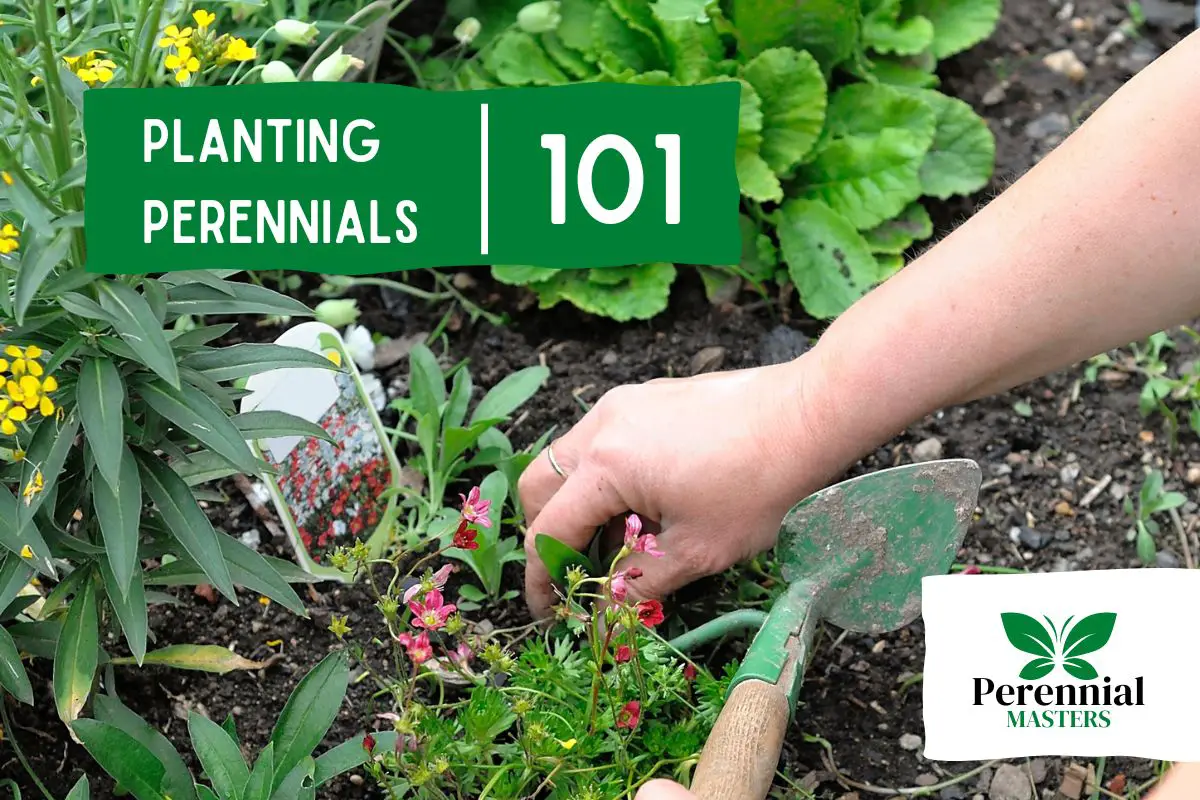I’ve been planting perennials for over 30 years and I still get excited when I start to prepare the dirt and get my plants ready to go into the ground!
In my opinion, every garden, landscaped area, and all other outdoor spaces can benefit by having a perennial or two.
When planting perennials you have a lot of choices that can add depth and color to almost any garden space. One of the greatest advantages to perennial planting is that you only have to plant them once but get to enjoy them for many years.
Table of Contents
Planting Perennial Plants
Perennials can be planted during most parts of the year, from the end of the last freeze to the months leading up to winter. Although some plants can handle being planted in winter, it is always best to get perennials in the ground before the ground gets hard and frozen. Popular perennials are Liatris, monkshood, brunnera, and hellebores.
Whether you are looking for some ground cover or adding color to a garden’s border, you will find the perfect perennial for that space.
We have put together this step-by-step guide, on planting perennials, with some tips and tricks to help you get the job done! So, let’s get into it!
How To Choose Perennials
Choosing perennials is the first step to planting, and to me, the most fun part of the journey! Now is when you look at what spaces you have to work with, what types of light and soil conditions these areas get, and decide what you are looking for in your perennials.
You should make sure that any perennial that you are planting is a plant that does well in your growing zone.
For some, color is the most important part of choosing what perennials to plant. You have many options in color, size, and type of perennial. Perennial bushes can add some structure to your home and garden, while flowers add a touch of color to borders and areas where they pop. Many perennial bushes also have blooms that add small splashes of color!
Once you have determined what types of perennials you want, what your needs are, and where they are going to go, you’re ready to start preparing to plant them!
See our article for Liatris Colors!
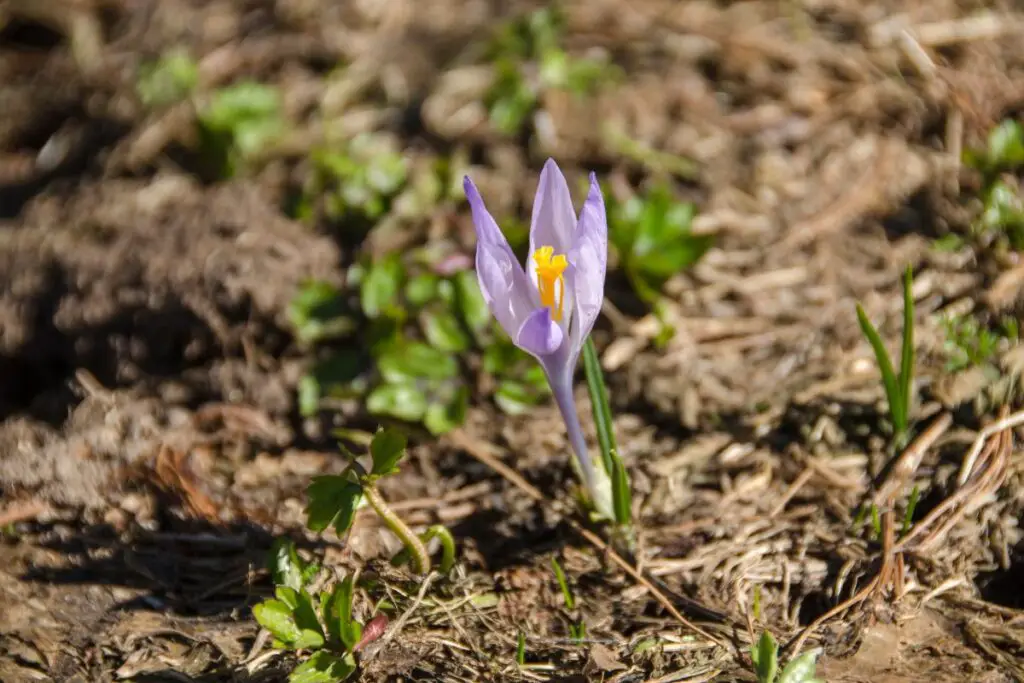
What Month Should Perennials Be Planted
Most perennials can be planted from the last frost to around fall. However, some perennial plants need to be planted during a specific season.
The best time to plant perennials will depend on the climate in which you live and the type of plants you are growing. The best time to plant perennials is during the spring months, as this provides optimal conditions for them to thrive.
In climates with mild winters, planting may be done as early as late February, whereas, in colder climates, planting should be done in mid-April.
If you are planting a wide variety of perennials, you may want to stagger your planting times. This will help ensure that you are able to enjoy blooms from each of your plants throughout the growing season.
Some perennials may bloom in the summer, while others may bloom in the fall, so it is important to be aware of the different bloom times for each of your plants. If you are planting perennials from seeds, you may need to start them indoors and then transplant them once the weather is warm enough for them to thrive. This will give the plants enough time to establish themselves.
See our article for Perennials That Bloom All Summer
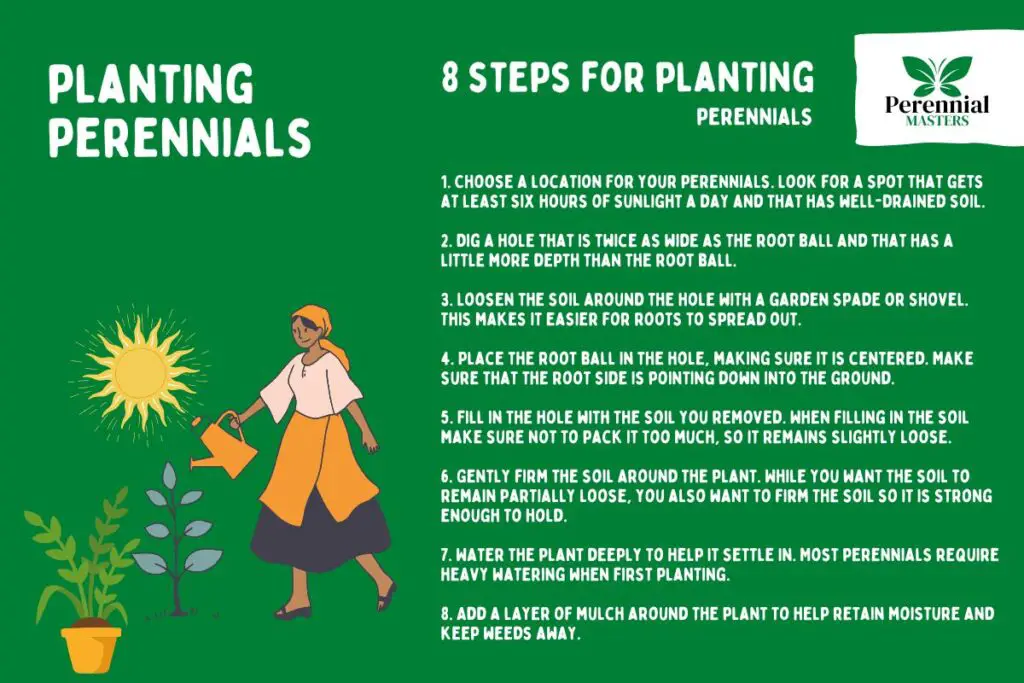
How To Plant Perennials (Step-By-Step)
Planting perennials can be an easy process as long as you follow these easy steps that we have put together. Remember that you need to choose perennials that are right for your climate, make sure you have the right space, ad that your sunlight conditions are correct.
1. Choose a location for your perennials. Look for a spot that gets at least six hours of sunlight a day and that has well-drained soil.
2. Dig a hole that is twice as wide as the root ball and that has a little more depth than the root ball.
3. Loosen the soil around the hole with a garden spade or shovel. This makes it easier for roots to spread out.
4. Place the root ball in the hole, making sure it is centered. Make sure that the root side is pointing down into the ground.
5. Fill in the hole with the soil you removed. When filling in the soil make sure not to pack it too much, so it remains slightly loose.
6. Gently firm the soil around the plant. While you want the soil to remain partially loose, you also want to firm the soil so it is strong enough to hold.
7. Water the plant deeply to help it settle in. Most perennials require heavy watering when first planting.
8. Add a layer of mulch around the plant to help retain moisture and keep weeds away.
That’s all you need to get your perennial project started! Make sure that you research your specific perennials, so that you know exactly how much to water, where they need to be, and how much sun they should get.
Planting Perennials From Seed
Planting perennials from seed is a great way to plant lots of plants without spending too much on bulbs and starter plants.
To get started, choose a location that works well for the type of perennial that you are planting. You’ll want to make sure the soil is well-drained and has plenty of organic matter.
After preparing the soil with compost or other amendments, it’s time to sow your seeds. When sowing perennials, it’s important to follow the directions on the package. Some seeds need light to germinate, so they should be sprinkled on the surface of the soil.
Other seeds need to be covered with soil, so use a small garden spade or use your finger to lightly press them into the soil. Once you’ve planted your seeds, you’ll need to keep the soil moist until the seeds sprout. You can do this by watering lightly every day or misting the soil. Once the plants are established, you can decrease your watering schedule.
If you’re planting a mix of different perennials, be sure to label each planting area with the name of the plant. This will help you keep from getting them mixed up! And believe me, I’ve done it.
While some growings like to plant from seed, many prefer to use already established plants.
How Do You Arrange Perennials in a Garden?
When it comes to designing your garden, perennials are a great way to add color and texture to your landscape. But how do you arrange these plants to get the best possible design? Here are some tips to help you create the perfect perennial garden.
First, decide where you want your perennials to go. Think about the colors, shapes, and sizes of the plants, and how they will look together. Consider the light and water requirements for each plant, and pick a spot in your garden that will provide the right conditions for each.
Once you’ve chosen the right spot, it’s time to get planting. Start by planting the largest and tallest plants first, as they will form the backbone of your garden. Place them in an orderly fashion and be sure to leave enough space between them so they won’t compete for resources.
Next, add medium-sized perennials. These can be placed in between the larger plants to create a more varied look. If you’re planting several of the same types of plants, be sure to space them out to avoid overcrowding.
Finally, add the small and low-growing perennials. These can be used to fill gaps and add a splash of color to the garden. Consider planting them in clusters, as this will help create a cohesive look.
When you’re done, step back and admire your work. With the right combination of plants, you can create a stunning landscape that will last for years to come.
Maximizing Garden Beauty with Closely Planted Perennials
Spacing is important when planting any type of plant. When planting perennials close together, you will want to keep a few things in mind. First, make sure that the plants you are planting closely together do not spread.
Planting plants that spread too close together can overcrowd them and cause problems in your happy little garden!
One of the biggest advantages of planting perennials close together is that it can limit the spread of weeds. Weeds can easily take over a garden if given the chance, but if the perennials are planted close together, it will be more difficult for the weeds to establish themselves.
Also, planting perennials close together can help to conserve moisture in the soil, making them less reliant on frequent watering. Another advantage to planting perennials close together is that it can help to create a lush, full garden bed. When perennials are spaced out, they can often look sparse, but when planted close together, they will create a dense, full look.
This can be especially helpful in smaller gardens, where every bit of space needs to be utilized, or in areas that you want to look thick. It is important to choose plants that are compatible with each other. Certain perennials can spread aggressively, and if placed too close to other plants, they can overtake them.
It is also important to give each plant enough space to grow and establish itself, as overcrowding can cause poor growth or even death in perennial plants.
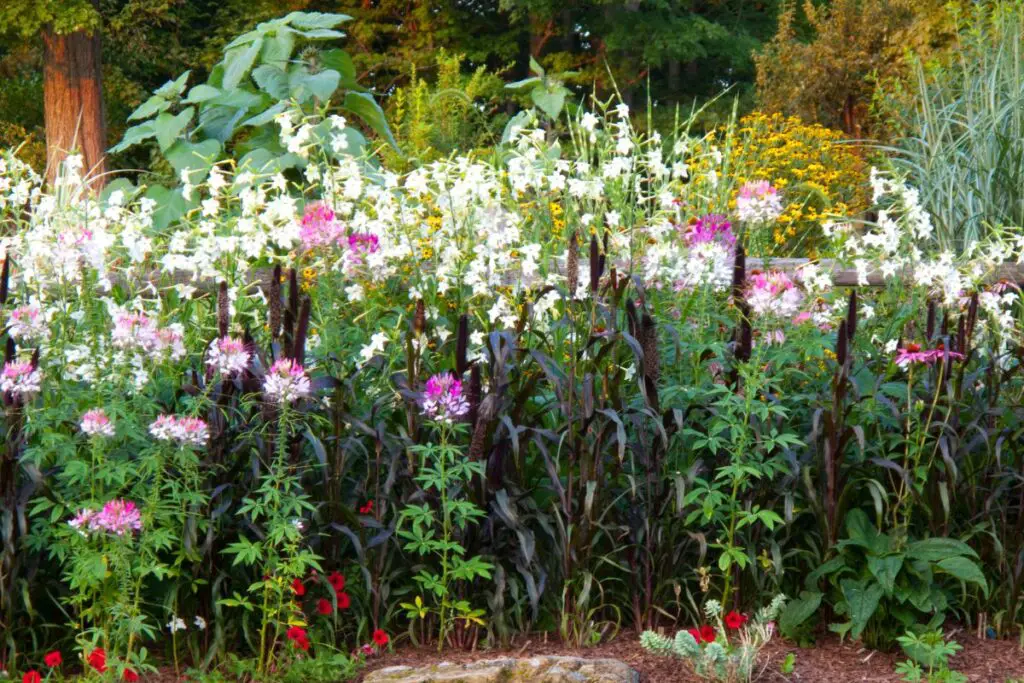
Harmonize Your Garden with Perennial Companions!
With perennial companion plants, you are able to place plants together that benefit each other in some way. You can pair things together, by planting a perennial that needs help pollinating, next to a perennial that attracts butterflies.
Choosing the right perennials and companion plants is an important step when starting a perennial garden and it can help create an ecosystem, that your plants will thrive, together in. They create a symbiotic relationship, where they share nutrients, and each plant helps the other to grow.
Here we have made a list with some of our favorite perennial plants and their companions!
Planting Perennials in Pots
Some perennial plants can be planted in pots! Planting in pots makes them mobile, which in return makes it easier to grow them in places that do not always meet the right growing conditions. If it is too hot in one area, you can move them to another.
Here are some of our favorite perennial plants to plant in pots:
- English Ivy
- Catmint
- Hosta
- Lavender
- Daylilies
- Yarrow
- Thyme
- Sedum
- Heuchera
- Black-Eyed Susan
Herbs always make the best plants for pots. I’ve grown thyme in pots a few times and have already had great results! Keep in mind that many perennial plants such as daylilies need to be watered more often in pots than in the ground.
Container planting is a very popular way to enjoy plants, with the added benefit of being able to move them when you need to if they are in pots! They can be planted in other types of containers as well.
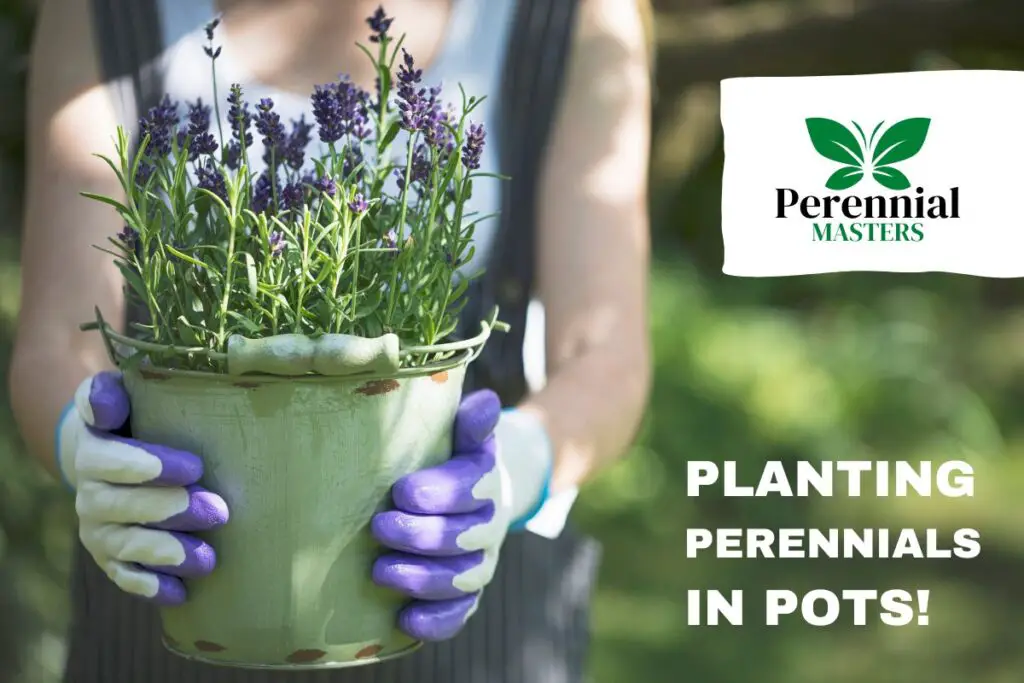
Best Compost For Planting Perennials
When planting perennials, the best compost to use is a nutrient-rich, organic soil amendment. This type of compost is often referred to as a “complete soil amendment” because it contains a balanced mix of minerals, organic matter, and beneficial microbes, which are great for your perennials.
Organic soil amendments are made from things like composted manure, wood chips, and shredded leaves. These materials are broken down by beneficial microbes and release their nutrients into the soil. By adding organic soil amendments to the planting bed, you’ll ensure your perennials get the necessary nutrients for healthy growth and blooms.
How Long Do Perennials Take to Establish
The answer to this question depends on a number of factors, including the type of perennial, the climate, and the soil and water conditions. Generally, it can take anywhere from one year to several years for a perennial to become established in its new environment.
In the first year, perennials are usually slow-growing. During this time, they are busy establishing their root systems and growing new leaves and stems. If the conditions are good, the plant may bloom during its first season.
In the second year, perennials usually start to fill out and bloom more heavily. During this time, the root system is well-established and the plant is more able to withstand drought and other environmental stresses.
By the third year, perennials are usually firmly established and in full bloom. At this point, they should be fairly low-maintenance and will require minimal care.
In some cases, it may take even longer for some perennials to become established. This is often the case in cooler climates or if the soil is particularly poor. In these cases, it may take up to five years before the plant is fully established and blooming.
To help speed up the establishment process, it is important to provide the plant with good soil, adequate water, and plenty of sun if that is what that plant calls for. Mulching can also help retain moisture and keep weeds at bay, which will allow the perennial to thrive.
Overall, it can take anywhere from one to five years for perennials to become established in their new environment. With the right care, they will provide you with beautiful blooms and foliage for many years to come, so if you ask me, they are well worth the wait!
How Often Should Newly Planted Perennials Be Watered?
In most cases, you should always water your perennials well during planting. Then they should be watered on a regular schedule after that. Some plants may need more or less water than others, so make sure you research your perennial plant for all of those details.
Usually, you will want to water them 1-2 times per week in the beginning, this will help them get established. Depending on the weather and soil conditions after a few weeks to a couple of months, you can start to water them a little less frequently.
When watering, it has been my personal experience that watering more deeply, less fluently, is usually better than watering them lightly, more often. You should always be monitoring the soil moisture so that it stays at the optimal moisture level for that type of perennial.
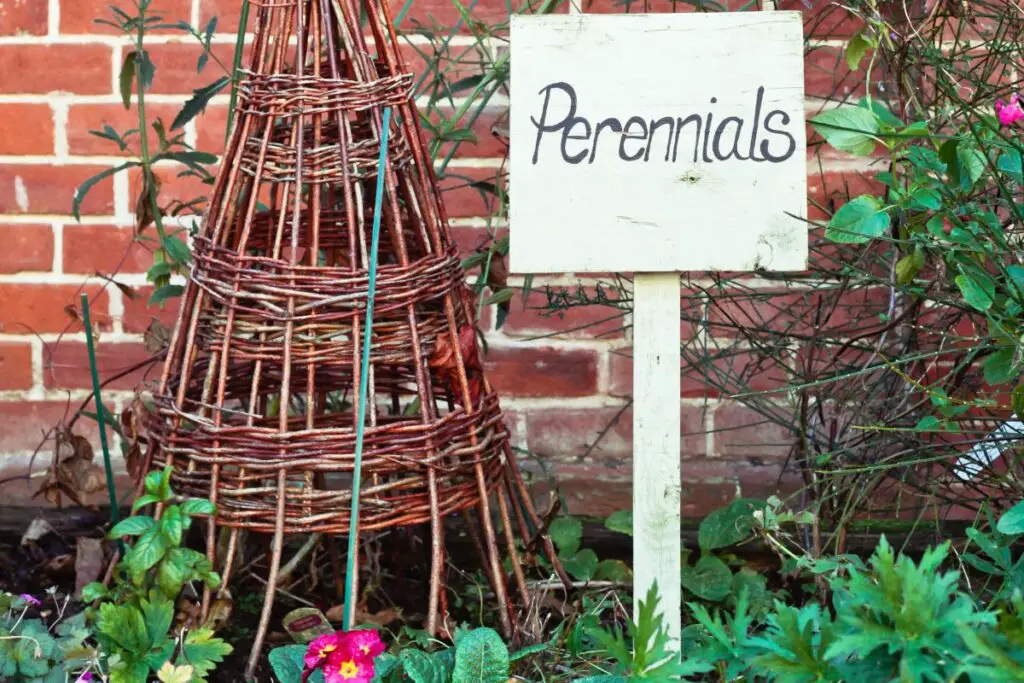
Can You Dig Up Perennials and Replant Them?
Yes, it is possible to dig up perennials and replant them. However, it is my experience that many perennial plants do not take well to being moved. If you are able to divide your perennials, this can be a great way to use some of the divisions in another area of your garden.
When doing so, make sure that the soil is loose enough and that it meets all of the requirements of your plant. The best time to move perennials is in late summer to early fall. During this time the plants should be in a dormant state, which will take less of a toll on the plants.
Find the Perfect Fertilizer for Your Perennial Garden
Fertilizers can be an important part of keeping your plants happy and healthy. They need nutrients to grow and making sure they get exactly what they need is going to be key to their success.
Depending on your soil conditions, you will need to make sure they get the correct balance of nitrogen, phosphorus, and potassium. You have many options when it comes to fertilizing perennials, such as slow-release fertilizer, which will feed your plant slowly, over time. This is a great option for perennials!
You can also use compost and composted manure as fertilizers! Organic fertilizer is often the best way to go!
Perennial gardening is a great way to bring more beauty and life to your garden – and it doesn’t have to be hard! With careful planning and preparation, you can enjoy a beautiful, low-maintenance garden for years to come.
Now that you know how to go about planting your perennials, let’s look at a few frequently asked questions.
FAQ
Most perennials are hardy and can survive some level of frost. Only with certain types of perennials, such as hostas, would you consider covering them. Covering plants that do not need it can cause damage to the plant so make sure to research if your specific perennial reacts well to covering.
Yarrow is the hardiest perennial flower that I have come across. It is a long-blooming, drought-tolerant, and low-maintenance flower that can be found in a wide variety of colors.t grows strong and tolerates frost
Perennials typically need soil that is at least 8-12 inches deep to promote strong root growth and nutrient absorption. The general rule is that you should have at around 8 inches so the root system has plenty of room to grow.
Most perennials do not need water every day. They should typically be watered 1-2 times per week. When first planting you want to make sure that they are watered in a good amount. Then, you start watering them with around 1 inch of water per week.

